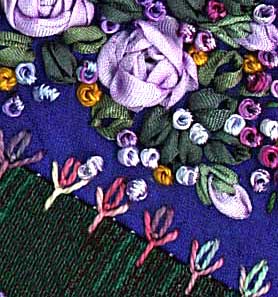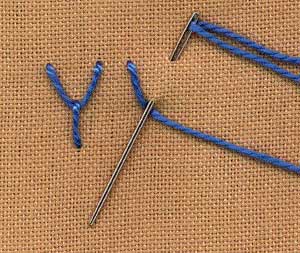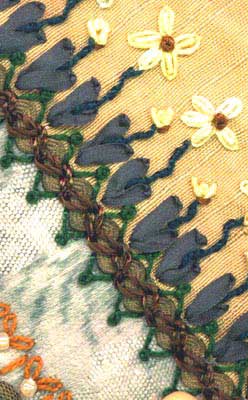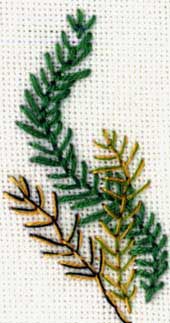Fly stitch

![]() Fly stitch is also known as 'Y' stitch, and open loop stitch. Fly stitch is worked easily since it is made up of a V-shaped loop which is then tied down by a vertical straight stitch.
Fly stitch is also known as 'Y' stitch, and open loop stitch. Fly stitch is worked easily since it is made up of a V-shaped loop which is then tied down by a vertical straight stitch.
To begin Fly stitch, bring the thread through the fabric out at the top and to the left of the line that is to be worked.
Hold the thread down with the left thumb and insert the needle a small space, level and to the right of where the thread first came out.
Make a small stitch downwards to the center.
With the thread wrapped under the needle, pull it through the fabric and secure it in position with a small loop.
 The tying stitch that secures the loop can vary in length to produce different effects.
The tying stitch that secures the loop can vary in length to produce different effects.
Some refer to the stitch I have illustrated as long tailed Fly since the stitch that ties it down is longer.
Varieties can be developed by tying the loop with bullion stitches, a simple chain stitch, or french knots.

Another stitch that looks effective as a tie is Oyster stitch.
You can change the length of the tie working short and long ties alternatively.
Spacing can be changed producing a pattern. Or for contemporary needlework work fly stitch in an irregular manner in different weights and colour's of of thread.

Fly stitch can also be stacked closely together to produce leaf shapes.
Isolated fly stitches can be scattered across an area.
Border patterns can be built up by arranging the stitches side by side along a horizontal line. Fly stitch can also be arranged in vertical row. It is often incorporated in floral patterns and designs as twiggy foliage.
Varieties of Fly stitch
There are a number of varieties and developments of Fly stitch. These are listed under Closed fly stitch, Plaited fly stitch, Reversed fly stitch, Threaded fly stitch, Threaded reversed fly stitch, Whipped fly stitch, and Whipped reversed fly stitch.
